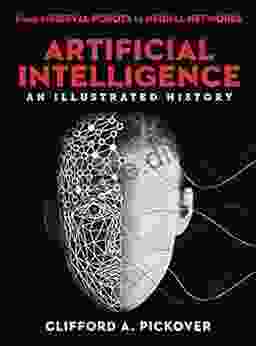From Medieval Robots to Neural Networks: A Captivating Exploration of Robotics History

The world of robotics has captured our imaginations and transformed numerous aspects of our lives. From self-driving cars to industrial automation, robots are playing an increasingly significant role in shaping our future. However, the origins of this field extend far beyond the modern era, with roots deeply embedded in the annals of history.
In this comprehensive guide, we will embark on an enthralling journey through the history of robotics, tracing its evolution from the rudimentary automatons of medieval times to the sophisticated neural networks of today. Along the way, we will encounter brilliant minds, groundbreaking inventions, and captivating stories that have propelled this field forward.
4.3 out of 5
| Language | : | English |
| File size | : | 75242 KB |
| Text-to-Speech | : | Enabled |
| Enhanced typesetting | : | Enabled |
| Word Wise | : | Enabled |
| Print length | : | 226 pages |
| Screen Reader | : | Supported |
Medieval Beginnings
The concept of creating artificial beings has captivated human imagination for centuries. In the Middle Ages, ingenious artisans crafted intricate automatons that could perform simple tasks. These early robots, often constructed from wood or metal, were powered by springs, weights, or water.
One of the most famous examples of a medieval robot is the "Elephant Clock" created by Al-Jazari in 1206. This elaborate device featured a water-powered elephant that could dispense water from its trunk, while attendants played music and a scribe recorded the time.
Renaissance and Enlightenment
During the Renaissance and Enlightenment periods, the pursuit of knowledge and scientific inquiry flourished. This intellectual climate fostered a renewed interest in robotics, with inventors seeking to create machines that could mimic human abilities.
Leonardo da Vinci, the Renaissance polymath, sketched designs for several ingenious robots, including an armored knight and a self-propelled cart. While these designs were not built in his lifetime, they showcased the visionary thinking and creativity that would later inspire future generations.
The Industrial Revolution and Beyond
The Industrial Revolution marked a turning point in the history of robotics. As factories became increasingly mechanized, there was a growing need for machines that could perform repetitive tasks with precision. In 1738, Jacques de Vaucanson created an automated loom that could weave complex patterns.
Throughout the 19th and 20th centuries, advancements in materials science, electronics, and computing led to the development of increasingly sophisticated robots. These machines found applications in manufacturing, transportation, space exploration, and other fields.
The Rise of Artificial Intelligence
The advent of artificial intelligence (AI) in the mid-20th century revolutionized the field of robotics. AI algorithms enabled robots to learn, adapt, and make decisions autonomously. This opened up new possibilities for robots to operate in complex and unpredictable environments.
In the 1950s, George Devol and Joseph Engelberger founded Unimation, the first company to produce and sell industrial robots. These early robots were primarily used for welding, painting, and assembly tasks.
The Age of Neural Networks
In recent years, the field of robotics has been transformed by the rise of neural networks. These powerful AI algorithms are inspired by the structure and function of the human brain. Neural networks have enabled robots to achieve unprecedented levels of performance in tasks such as object recognition, speech processing, and decision-making.
Self-driving cars, for example, rely on neural networks to interpret sensor data, detect obstacles, and make real-time decisions. Neural networks are also being used to develop robots that can assist with healthcare, education, and security.
The history of robotics is a testament to human ingenuity and the relentless pursuit of innovation. From the humble beginnings of medieval automatons to the sophisticated neural networks of today, robots have played a profound role in shaping our world.
As we look to the future, the field of robotics is poised for even greater advancements. With rapid developments in AI, machine learning, and other technologies, we can expect robots to become even more intelligent, adaptable, and capable.
Whether we are exploring the depths of space, revolutionizing manufacturing processes, or seeking to improve the human condition, robots will undoubtedly continue to play a vital role in shaping our future.
4.3 out of 5
| Language | : | English |
| File size | : | 75242 KB |
| Text-to-Speech | : | Enabled |
| Enhanced typesetting | : | Enabled |
| Word Wise | : | Enabled |
| Print length | : | 226 pages |
| Screen Reader | : | Supported |
Do you want to contribute by writing guest posts on this blog?
Please contact us and send us a resume of previous articles that you have written.
 Book
Book Novel
Novel Page
Page Chapter
Chapter Text
Text Story
Story Genre
Genre Reader
Reader Library
Library Paperback
Paperback E-book
E-book Magazine
Magazine Newspaper
Newspaper Paragraph
Paragraph Sentence
Sentence Bookmark
Bookmark Shelf
Shelf Glossary
Glossary Bibliography
Bibliography Foreword
Foreword Preface
Preface Synopsis
Synopsis Annotation
Annotation Footnote
Footnote Manuscript
Manuscript Scroll
Scroll Codex
Codex Tome
Tome Bestseller
Bestseller Classics
Classics Library card
Library card Narrative
Narrative Biography
Biography Autobiography
Autobiography Memoir
Memoir Reference
Reference Encyclopedia
Encyclopedia Craig W Schneider
Craig W Schneider Rob Kearney
Rob Kearney Sonya Loveday
Sonya Loveday Cinda Williams Chima
Cinda Williams Chima Polly Shulman
Polly Shulman Claudia Cangilla Mcadam
Claudia Cangilla Mcadam Francine Pascal
Francine Pascal Cindy Ray Hale
Cindy Ray Hale Malcolm Andrews
Malcolm Andrews Raquel Vasquez Gilliland
Raquel Vasquez Gilliland Cyrus Hamlin
Cyrus Hamlin Rob Garay
Rob Garay Cynthia Quarta
Cynthia Quarta Christy Mihaly
Christy Mihaly Mark Peters
Mark Peters Curtis E Harvey
Curtis E Harvey Craig Garber
Craig Garber Derek Gladwin
Derek Gladwin Pierre Sundborg
Pierre Sundborg Paul Robinson
Paul Robinson
Light bulbAdvertise smarter! Our strategic ad space ensures maximum exposure. Reserve your spot today!

 David MitchellUnveiling the Dark Truth: A Riveting Journey into "Dissever" by Tracey Ward
David MitchellUnveiling the Dark Truth: A Riveting Journey into "Dissever" by Tracey Ward
 Vladimir NabokovGolden Dreg Quake Golden Dreg World: A Literary Masterpiece that Captivates...
Vladimir NabokovGolden Dreg Quake Golden Dreg World: A Literary Masterpiece that Captivates... Gage HayesFollow ·14.2k
Gage HayesFollow ·14.2k Milan KunderaFollow ·15.4k
Milan KunderaFollow ·15.4k Anthony BurgessFollow ·10k
Anthony BurgessFollow ·10k Douglas FosterFollow ·12.5k
Douglas FosterFollow ·12.5k John UpdikeFollow ·7.8k
John UpdikeFollow ·7.8k Jake PowellFollow ·2.6k
Jake PowellFollow ·2.6k Ralph Waldo EmersonFollow ·18.6k
Ralph Waldo EmersonFollow ·18.6k Roy BellFollow ·14k
Roy BellFollow ·14k

 Howard Blair
Howard BlairThe Bewitching of Camille: A Mystical Tapestry of...
Prepare to be...

 Kirk Hayes
Kirk HayesUnraveling the Enigmatic Tale of "Vanished But Still...
In the labyrinth of memory...

 Joe Simmons
Joe SimmonsDogwild: An Unforgettable Literary Odyssey into the Heart...
Delve into the Untamed...

 Edgar Allan Poe
Edgar Allan PoeIndulge in Culinary Delights: Your Ultimate Costa Brava...
Discover the Flavors of Spain's Coastal...
4.3 out of 5
| Language | : | English |
| File size | : | 75242 KB |
| Text-to-Speech | : | Enabled |
| Enhanced typesetting | : | Enabled |
| Word Wise | : | Enabled |
| Print length | : | 226 pages |
| Screen Reader | : | Supported |












